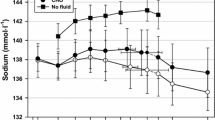Summary
The purpose of these experiments was to examine the influence of various fluid replacement drinks on exercise-induced disturbances in homeostasis during heavy exercise. Nine trained cyclists performed constant load exercise on a cycle ergometer to fatigue on three occasions with 1-week separating experiments. The work rate was set initially at ∼ 85% of\(\dot V_{o_{2{\text{ }}max} } \) (range 82–88%) with fatigue being defined as a 10% decline in power output below the initial value. During each experiment subjects consumed one of the following three beverages prior to and every 15 min during exercise: (1) non-electrolyte placebo (NEP; 31 mosmol · kg−1); (2) glucose polymer drink containing electrolytes (GP; 7% CHO, 231 mosmol · kg−1), and (3) electrolyte placebo drink without carbohydrate (EP; 48 mosmol · kg−1). Both the GP and EP beverage contained sodium citrate/citric acid (C) as a flavoring agent while C was not contained in the NEP drink. Although seven of nine subjects worked longer during the GP and EP treatment when compared with the NEP trial, the difference was not significant (P>0.05). No differences (P>0.05) existed between the GP and EP treatments in performance time. Exercise changes in rectal temperature, heart rate, Δ % plasma volume and plasma concentrations of total protein, free fatty acids, glucose, lactate, potassium, chloride, calcium, and sodium did not differ (P>0.05) between trials. In contrast, blood hydrogen ion concentration [H+] was significantly lower (P<0.05) at 30 min of exercise during the GP and EP treatment when compared with the NEP run. These data provide evidence that electrolyte drinks do not minimize exercise-induced disturbances in blood-electrolyte concentrations during heavy execrcise when compared with nonelectrolyte drinks; however, these results suggest that fluid replacement beverages containing buffers (i.e. C) and/or electrolytes may minimize blood alterations in [H+] during intense exercise. Additional research is required to determine if the buffering influence of these beverages has an ergogenic benefit during heavy exercise.
Similar content being viewed by others
References
Adams RP, Welch HG (1980) Oxygen uptake, acid-base status, and performance with varied inspired oxygen fractions. J Appl Physiol 49:863–868
Coggin R, Coyle E (1988) Effect of carbohydrate feedings during high intensity exercise. J Appl Physiol 65:1703–1709
Costill D, Cote R, Fink W (1976) Muscle water and electrolytes following varied levels of dehydration in man. J Appl Physiol 40:6–11
Coyle EF, Hagberg J, Hurley B, Martin W, Ehsani A, Holloszy J (1983) Carbohydrate feeding during prolonged strenuous exercise can delay fatigue. J Appl Physiol 55:230–235
Dill D, Costill D (1974) Calculation of percentage changes in volumes of blood, plasma, and red cells in dehydration. J Appl Physiol 37:247–248
Ferrannini E, Barrett E, Bevilaequas S, Dupre J, Defronzo R (1982) Sodium elevates the plasma glucose response to glucose ingestion in man. J Clin Endocrinol Metab 54:455–458
Fortney S, Wenger C, Bove J, Nadel E (1984) Effect of hyperosmolality on control of blood flow and sweating. J Appl Physiol 57:1688–1695
Hainline A (1958) Determination of blood hemoglobin concentration. Clin Chem 2:49–52
Ivy J, Costill D, Fink W, Lower R (1979) Influence of caffeine and carbohydrate feedings on endurance performance. Med Sci Sports 11:6–11
Ivy J, Miller W, Dover V, Goodyear L, Sherman W, Farrell P, Williams H (1983) Endurance improved by ingestion of a glucose polymer supplement. Med Sci Sports Exerc 15:466–471
Maughan R, Fenn C, Gleeson M, Leiper J (1987) Metabolic and circulatory responses to the ingestion of glucose polymer and glucose/electrolyte solutions during exercise in man. Eur J Appl Physiol 56:356–362
Neufer P, Costill D, Flynn M, Kirwan J, Mitchell J, Houmard J (1987) Improvements in exercise performance: effects of carbohydrate feedings and diet. J Appl Physiol 62:983–988
Nielson B, Sjogaard G, Ugeling B, Dohlman B (1986) Fluid balance in exercise dehydration and rehydration with different glucose-electrolyte drinks. Eur J Appl Physiol 55:318–325
Noakes T, Goodwin N, Rayner B, Branken T, Taylor R (1985) Water intoxication: a possible complication during endurance exercise. Med Sci Sports Exerc 17:370–375
Owen M, Kregel J, Wall PT, Gisolfi C (1986) Effects of ingesting carbohydrate beverages during exercise in the heat. Med Sci Sports Exerc 18:568–575
Powers S, Dodd S, Garner R (1984) Precision of ventilatory and gas exchange alterations as a predictor of the anaerobic threshold. Eur J Appl Physiol 52:173–177
Scholander PF (1947) Analyzer for accurate estimation of respiratory gases in one-half cubic centimeter samples. J Biol Chem 167:235–250
Schultz S (1981) Salt and water absorption by mammalian small intestine. In: Johnson J (ed) Physiology of the gastrointestinal tract. Raven Press, New York, pp 983–989
Severinghaus J (1966) Blood gas calculator. J Appl Physiol 21:1108–1116
Sigma Technial Bulletin (1968) No. 826-UV
Stewart P (1981) How to understand acid-base: a quantitative acid-base primer for biology and medicine. Elsevier, New York
Yallow R, Berson S (1960) Immunoassay of endogenous plasma insulin in man. J Clin Invest 39:1157–1175
Author information
Authors and Affiliations
Rights and permissions
About this article
Cite this article
Powers, S.K., Lawler, J., Dodd, S. et al. Fluid replacement drinks during high intensity exercise effects on minimizing exercise-induced disturbances in homeostasis. Europ. J. Appl. Physiol. 60, 54–60 (1990). https://doi.org/10.1007/BF00572186
Accepted:
Issue Date:
DOI: https://doi.org/10.1007/BF00572186




